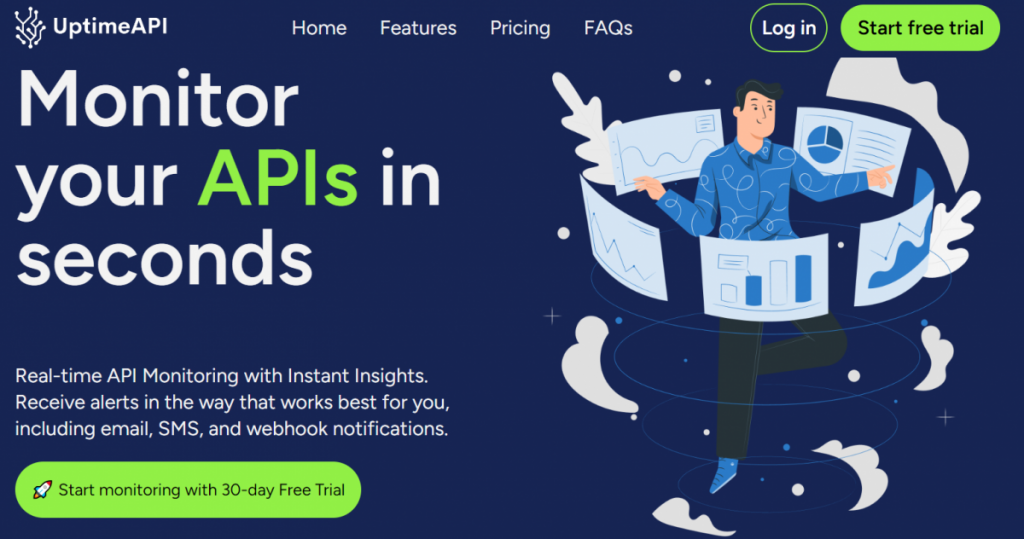In the ever-evolving landscape of software development, the reliability and performance of APIs are paramount. Monitor An API ensures a seamless experience for users and provides developers with crucial insights to enhance performance. In this tutorial, we’ll explore an indispensable tool for API monitoring in 2024 – UptimeAPI. This step-by-step guide will walk you through the process of setting up UptimeAPI, along with insights into interpreting API responses, essential for maintaining robust and responsive applications.
Why API Monitoring is Crucial in 2024:

As technology continues to advance, APIs become more integral to our digital experiences. Applications rely on interconnected services, and any disruption in API functionality can have widespread implications. Monitoring your API in 2024 is not just a best practice; it’s a necessity to ensure optimal performance, reliability, and user satisfaction.
Step 1: Introduction to UptimeAPI in 2024:
UptimeAPI, in 2024, has emerged as a sophisticated API monitoring tool, equipped with features to meet the demands of modern development. With an intuitive interface and advanced customization options, UptimeAPI provides developers with real-time insights into their API’s performance.
Step 2: Account Setup and Dashboard Overview:
Begin by signing up for a UptimeAPI account, which offers a seamless onboarding process. Upon logging in, you’ll be greeted with a user-friendly dashboard. Navigating through the dashboard, you’ll find an array of tools and features designed to simplify the monitoring process.
Step 3: Adding a New API Monitor:
In the “Monitors” section of the dashboard, initiate the process of adding a new monitor. Input the details of the API you wish to monitor, including the endpoint URL and monitoring frequency. UptimeAPI supports various check types, providing flexibility for developers working with diverse APIs.
Step 4: Customizing Monitoring Parameters:
UptimeAPI in 2024 comes with enhanced customization options. Tailor monitoring parameters to match your specific needs. Define the type of check (HTTP, HTTPS, TCP), set expected response times, and configure alert notifications. These customization features ensure that UptimeAPI delivers precise information about your API’s performance and availability.
Understanding API Responses in 2024:

API responses remain a crucial aspect of effective monitoring. In 2024, a well-functioning API should still return a response with a status code in the 2xx range, indicating success. For example, a 200 OK status code signifies a successful request.
However, it’s essential to stay updated on potential changes. New status codes might be introduced, and understanding them is vital. Familiarize yourself with the responses to ensure quick identification and resolution of issues.
Step 5: Setting Up Advanced Alert Notifications:
UptimeAPI’s alerting system has been refined to meet the evolving needs of developers. Configure advanced alert notifications through channels like email, SMS, or integration with collaboration platforms such as Slack. In 2024, UptimeAPI ensures that you stay informed about any issues, allowing for swift resolution and minimizing downtime.
Step 6: Leveraging Historical Data for Continuous Improvement:
UptimeAPI’s capabilities extend beyond real-time monitoring. Explore historical data and performance analytics to track API uptime and response times over time. Analyzing this data provides valuable insights into trends, potential bottlenecks, and areas for optimization, facilitating continuous improvement of your API infrastructure.
Conclusion:
As we navigate the technological landscape of 2024, API monitoring remains a critical aspect of development. UptimeAPI, with its advanced features and user-friendly interface, stands out as an invaluable tool for developers. By following this easy tutorial, you’ve gained insights into setting up UptimeAPI and interpreting API responses, empowering you to create and maintain high-performing APIs.
Embrace the power of UptimeAPI to ensure the reliability of your APIs, minimize downtime, and deliver exceptional user experiences. Stay informed, stay proactive, and let UptimeAPI be your go-to solution for API monitoring in 2024 and beyond. Happy coding!
Read More: Company profile APIUsage Cases

